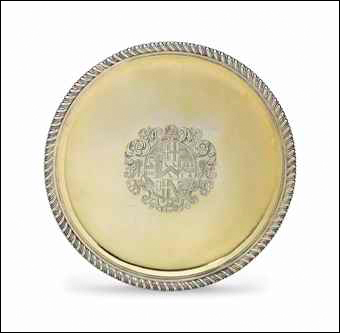Queen Anne silver-gilt 'tazza'
Pierre Platel, 1712

This handsome and significant piece of English silverwork has a direct connection to the Johnson family, owners of the medieval Ayscoughfee Hall from the mid-17th century until 1898. The tazza was made in 1712 by Pierre Platel, a French Huguenot who fled France for England in 1685. In 1697 he was naturalised as a British citizen, and he entered his first mark as a goldsmith in London in 1699. Among PlatelÂ’s clients were the 1st Duke of Devonshire and George, Prince of Wales (later George III). The shape of the piece is circular, raised on a pedestal foot and decorated with a gadrooned rim. In the centre is the engraved crest of Theophilus Fairfax Johnson, who was born at Ayscoughfee Hall in 1790. The piece bears the hallmark 1712. A very similar crest appears on the Johnson Cup, a silver-gilt loving cup made by Platel in 1712 and acquired by the museum with the assistance of the Art Fund in 2008. It is not known who commissioned the companion pieces, but it may have been Maurice Johnson II (1688-1755), a notable antiquarian and founder of the Spalding GentlemenÂ’s Society. The pieces may later have been engraved to mark an important moment in the life of Theophilus Johnson, possibly his marriage to Millicent Anne Moore whose arms also appear on the crest. Ayscoughfee Hall was sold to the people of Spalding in 1898 and its contents auctioned off. These silver-gilt objects are now a valuable reminder of the family who once lived there.
More information
Title of artwork, date
Queen Anne silver-gilt 'tazza', 1712
Date supported
2016
Medium and material
Silver-gilt
Dimensions
Diameter 35.6cm
Grant
5661.82
Total cost
17261.66
Art Funded by you FAQs
Contact us
If you have a question about a work of art in our archive, please contact the Programmes team. We’ll be happy to answer your enquiry.